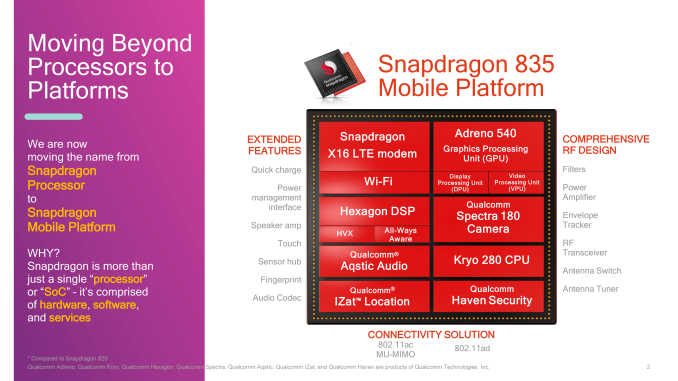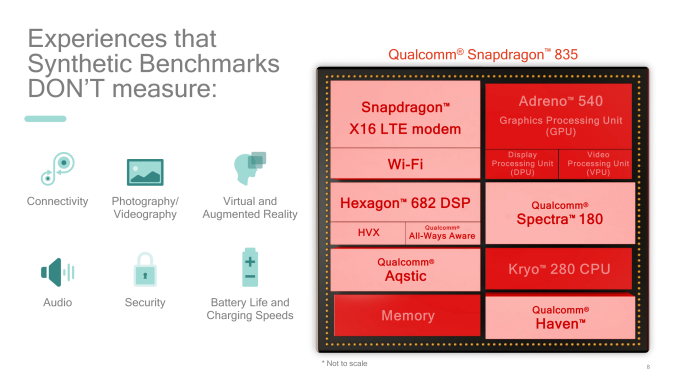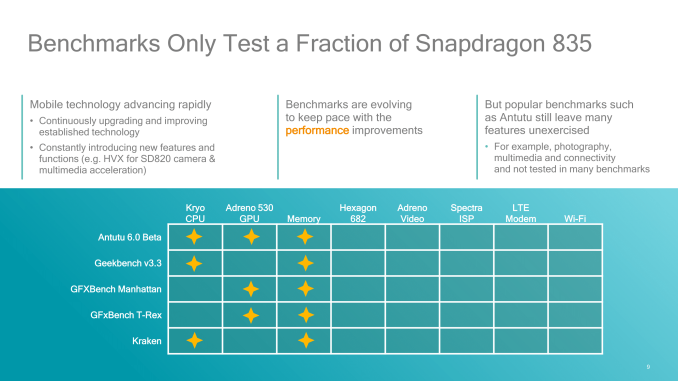The Qualcomm Snapdragon 835 Performance Preview
by Matt Humrick & Ryan Smith on March 22, 2017 4:30 AM EST- Posted in
- Smartphones
- Snapdragon
- Qualcomm
- Mobile
- SoCs
- Snapdragon 835
- Kryo
Qualcomm's Thoughts on Benchmarks versus End-User Experiences
While the primary purpose of our visit out to Qualcomm’s offices was for benchmarking, for this year’s event Qualcomm went one step further and invited us to take a tour of some of their labs. The tour itself was plenty interesting (more on this in a bit), however arguably the more important aspect of the tour isn’t what we saw, but why Qualcomm is giving the press lab tours after so long. A tour may sound trite, but for Qualcomm it’s a sign of bigger things.
Perhaps the most important thing to understand about Qualcomm is that while the bulk of the company’s revenue comes from chips, the majority of their actual profits come from various technology and patent licensing programs. The actual breakdown between the two halves of Qualcomm gets a bit weird when trying to best account for which half foots the bill for R&D, but at the end of the day it’s Qualcomm’s licensing business that is making them the most money.
| Qualcomm Financials (FY'2016) | ||||
| Chip-Making | Licensing | |||
| Revenue | $15.4B | $7.6B | ||
| Profit (Pretax) | $1.8B | $6.5B | ||
As a result, if boardroom-level rumors are to be believed, the company is never quite sure how to balance the two businesses. Some groups want licensing and chip design separated, and others want them to stay combined. Qualcomm seems content to stick with the status quo and their $5.7B in profits for 2016, but as a consequence of this unusual split it means that the chip side of Qualcomm is always under a bit of pressure to prove itself.
The good news for the chip business is that it’s doing fairly well, especially in North America. Most high-end Android smartphones sold in the US are based on Qualcomm’s chips, Qualcomm’s modems are in some (but no longer all) of Apple’s iPhone SKUs, and even in the midrange market Qualcomm’s Snapdragon 600 series chips are in a number of popular phones. The flip side of this is that outside of the US and especially outside of the high-end, Qualcomm’s chip business is under constant pressure from both their partners and their competitors. Samsung is happy to stick with their own home-grown Exynos chips outside of North America, and other chip vendors like MediaTek nip at Qualcomm’s heels with competent midrange SoCs that are priced very aggressively. So while Qualcomm’s chip business is doing well right now, that could very well change in the future.
But what does this have to do with a press tour of their labs? One of the big initiatives for Qualcomm, as exemplified in last week’s Snapdragon branding tweak, is that the chip arm of the company wants to get away from being so frequently judged on the basis of their CPU and only their CPU. This is why Snapdragon is now a platform versus a processor, and similarly, it’s why we’re going to see Qualcomm increasingly talking up the other aspects of their SoCs in the future. Their SoCs and associated front-end hardware are more than just the Kryo CPU, and they want the world to know that.
For Qualcomm this move makes a lot of sense. CPU performance is still growing year-after-year, but as we’ve seen, those gains are plateauing some as a consequence of diminishing IPC gains and diminishing clockspeed gains. Meanwhile, although the Kryo is a customized CPU design, as we’ve seen in our benchmark data it doesn’t behave radically different from ARM’s Cortex-A72 and Cortex-A73 designs that other vendors can license. Short of a “Cyclone” moment for Qualcomm, their CPU performance is close enough to the rest of the Android pack that they can’t clearly stand out from other vendors in the way Apple can. And that means they need to promote and sell their SoCs as the sum of their parts, and not just a CPU with a bunch of extra stuff bolted on.
This also means that even though Qualcomm is one of the first vendors to ship a 10nm high-end SoC – and enjoying the performance benefits thereof – we’re also going to see the company downplay benchmarks a bit for not capturing the complete “end-user experience.”
And to the company’s credit, they aren’t wrong. CPU, GPU, and memory performance are all easy enough to test, vary a great deal among SoC designs, and are similarly easy to communicate. DSPs, ISPs, and other aspects are not nearly as easy to test, never mind communicating those advantages to a wider audience.
Still, once we get outside of CPU/GPU/memory and into other functional blocks of a SoC, things get murkier for everyone. A video decode block may as well be a static piece of hardware – as long as it does its job well, no one will notice – and a great Wi-Fi radio can be kneecapped by a bad device design. So as much as Qualcomm wants to push the broader end-user experience, they will never completely escape the fact that the core features of their SoCs will be the first to be put to the test, and that wider testing is going to be less meaningful to customers, or more practically speaking outside the budgets of technology journalists.













128 Comments
View All Comments
joms_us - Thursday, March 23, 2017 - link
Well not quite 100% to me... Hell knows what background app is making those spikes and not Geekbenchhttp://i.imgur.com/IjBdsOHh.jpg
http://i.imgur.com/6FWmG5Jh.jpg
http://i.imgur.com/IjMsOjIh.jpg
Remember the news about benchmark cheating of Samsung and now Oneplus? What they did are perfectly valid because a worthless app like Geekbench does not measure the true IPC of the SoC if it can't maximize it. You go to Windows world, people will disable CnQ or Speedstep and Powernow just to make sure processor is running at 100% of frequency to measure true IPC.
P.S Thanks for the name of the app, I appreciate it!
realbabilu - Sunday, March 26, 2017 - link
I remember in Windows Pc,is hard to get all cores stay flat at 100% unless I got very good multithread multiprocessor designed program like Ansys or Abaqus. Means its very tough to get/program a software that can utilize all cores stay at 100%.
ah06 - Wednesday, March 22, 2017 - link
Please stop posting, your understanding of SoCs is less than primary school level and you are talking to experts like Andrei........ah06 - Wednesday, March 22, 2017 - link
Why are you on Anandtech? How old are you?Please do not post again
joms_us - Thursday, March 23, 2017 - link
Oh some God from heaven, sorry for stopping by here.lilmoe - Thursday, March 23, 2017 - link
lol, I was literally being sarcastic in my comment. Looks like it stirred a lot of angry replies.- Geekbench does scale well across all cores. That's not the problem. Geekbench sucks as a benchmark for "absolute" performance of the CPU portion of an SoC (or platform like QC likes to call it) that matters for modern workloads. In addition to that, the way it calculates the totals and how the devs decide what sub-score counts more than what is absolute BS. Most of the workloads it tests are rarely dealt with the CPU and more commonly offloaded to co-processors. Yes, even on iOS devices. I find the compute portion of geekbench rather interesting, but it's rarely discussed by anyone.
- CPUs are getting less and less relevant in modern content consumption workloads. Offloading to co-processors, if at all possible, is the way to go. For instance, Intel's latest 7700K CPU (cpu only) pales in comparison to the least efficient 4K encoding/decoding block implementation on any modern platform, including ARM based SoCs. The same goes for image processing/manipulation, audio, speech recognition, security, etc, etc.... You know, the sub-tests that Geekbench performs.
- Interconnect, bandwidth, cache throughput and latency, and Scheduling play a huge part in the multi-core score of a CPU/SoC. Generally, the more cores you have, the harder and more power consuming it is to scale multiple threads across those cores, _especially_ on processors constrained with a 2-4 watt power envelope. Those caches are very power hungry and often limit scaling by 10-20% of ST even on non-power limited CPUs. That percentage is much, MUCH higher on ultra mobile ARM parts.
- In addition to those scaling issues, the Snapdragon 835, similar to Samsung's Exynos and HiSilcon's Kirin SoCs are big.LITTLE multi-cluster configurations. Typically, only 1 of these clusters is high performance, and only when you're running a single or couple of threads would the high performance cores reach their highest clocks. That's by design of ultra-low power, passively cooled parts. The Exynos 8890 gets up to 2.6Ghz in ST and 2.2Ghz in MT. Again, in addition to clock variance, you'll never get 8x ST since only 4 of those 8 cores are high performance. The smaller cores are nowhere near as powerful. I say they would count as Intel's virtual threads in their hyper threading (SMT), and should help to achieve better scaling by just a tiny bit.
So, yea. I was being sarcastic. I agree with Qualcomm. These modern ARM SoCs are very sophisticated and tricky to benchmark. Nothing about them is simple. What ultimately matters is how much time it takes them to complete a modern workload, and how much power they consume at that. The more of these workloads are offloaded to co-processors, the better.
For the CPU portion, what matters in a smartphone/tablet, first and foremost, is multi-core performance, and how much of that performance is sustained over time with the least amount of power consumption. ST performance is overrated doesn't matter, AT ALL, after a certain performance threshold IN MOBILE DEVICES. Split second javascript gains as a result of browser optimization or real ST lead of a particular SoC are irrelevant. Javascript doesn't exist in a vacume, it's part of a web page/app, and how long it takes a browser to fully load a page and render its content is what ultimately matters. Period.
tuxRoller - Thursday, March 23, 2017 - link
"I find the compute portion of geekbench rather interesting, but it's rarely discussed by anyone."Why is that the case?
Btw, this is a much better comment.
What you are saying is why relevant benchmarks don't exist for mobile devices (sub-laptops).
The issue, i believe, is that sites, largely, test these devices like small computers (bear with me). As such, they focus on cpu related tasks. Some sites include video recording/playback power usage, but none, tmk, include task traces that are taken from someone actually using a device.
tuxRoller - Wednesday, March 22, 2017 - link
If all you care about is a running a headless server that can't communicate with the outside world, then, yeah!If you care about battery life and good performance, low power processors (microcontrollers or tiny a series cores used for handling interrupts or more general duties when in a low power state), dsps and gpus matter.
Do we need a hashtag?
prisonerX - Wednesday, March 22, 2017 - link
Yeah those graphics co-processors, what a joke.wardrive2017 - Wednesday, March 22, 2017 - link
Again I am impressed by the Snapdragon 625 showing here in the cpu tests, particulary in the PC mark tests, not so much in the Javascript. Still performing much better than expected. The G5 plus is starting to look quite appealing assuming its tweaked the same ways the Moto z play is